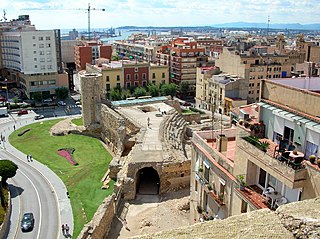
Tarragona is a coastal city and municipality in Catalonia (Spain). It is the capital and largest town of Tarragonès county, the Camp de Tarragona region and the province of Tarragona. Geographically, it is located on the Costa Daurada area on the Mediterranean shore.

A castell is a human tower built traditionally at festivals in a part of Catalonia (Spain), now also found in the rest of Catalonia, in the Balearic islands and in the Valencian Community.

Josep-Lluís Carod-Rovira is a Catalan politician. He was the Vice-president of the Catalan Government from 2006 to 2010. From 1996 to 2008 he was the leader of the Republican Left of Catalonia . ERC campaigns for Catalonia's independence from Spain and, secondarily, extend it to other Catalan Countries, the whole Catalan linguistic domain.
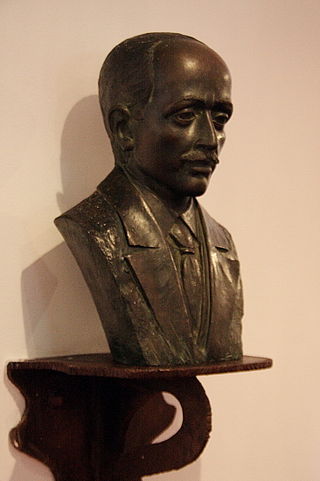
José María Jujol Gibert was a Catalan Spanish architect. Jujol's wide field of activity ranged from furniture designs and painting, to architecture. He worked with Antoni Gaudí on many of his most famous works. Among Jujol's projects are Casa Batlló, Casa Milà, Park Güell, and Our Lady of Montserrat, and among his design styles are Modernisme and Art Nouveau.

Vilanova i la Geltrú is the capital city of Garraf comarca, in the province of Barcelona, Catalonia, Spain. Historically, it is the result of the aggregation of the medieval center of La Geltrú with the center built outside the medieval walls, Vilanova. Initially, the lands of Vilanova belonged to Cubelles, the neighboring town. The city of Vilanova i la Geltrú has a growing population of approximately 66,000, and is situated 40 km south-west of Barcelona, with the coastal resort of Sitges some 10 km to the north-east.
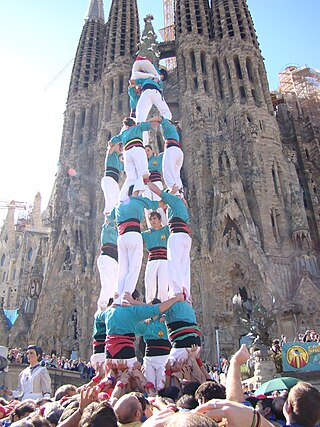
There are quite a number of festivals and traditions in Catalonia (Spain). While most are of ancient origin, certain traditions are of relatively recent introduction. There are also some that are common to the whole Catalan society, but others are relevant only to a particular location. Generally, locals welcome outsiders to share with them in their celebration.
Football is the most important sport in Catalonia and was introduced in the late 19th century by a combination of mostly British immigrant workers and visiting sailors, and students returning from Britain. Catalonia led the way in the development of football in Spain, organizing both the first association and the first championship. Today football in Catalonia is organized by the Catalan Football Federation and the RFEF and teams from Catalonia compete in La Liga, the Copa del Rey, the Copa Catalunya and several European competitions.
Castellbisbal is a municipality in the comarca of Vallès Occidental in Catalonia. It is situated on the left bank of the Llobregat river at its confluence with the Rubí river. The town is served by the A-7 autopista, the main N-II road and the Renfe railway line R4 between Barcelona and València.

The Santa Tecla Festival is a festival held in Tarragona, Catalonia, Spain.
The Concurs Internacional de Focs Artificial is the most important fireworks contest in the Mediterranean area. It is held on the first week of July in Tarragona, Spain at Punta del Miracle, a bay praised by the famous architect Antoni Gaudí for its beauty. Celebrated since 1321, the festival and is recognized as an event of national touristic interest by Spanish government. Each year the City Council of Tarragona elects a board of judges, which then selects the six international pyrotechnic companies that will compete. The order in which the contestants will appear is decided through a draw.
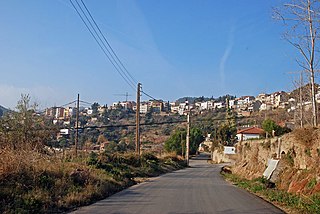
Sant Feliu de Codines is a municipality in the comarca of Vallès Oriental, Catalonia, Spain. It is located in the north-west corner of the comarca, on the border with comarca of Moianès to the north, and the comarca of Vallès Occidental to the west.

La Mercè is the annual festival of the city of Barcelona in Catalonia, Spain. It has been an official city holiday since 1871, when the local government first organized a program of special activities to observe the Roman Catholic feast day of Our Lady of Mercy. Although the actual feast day is September 24, the festivities begin a few days beforehand.

Rail transport in Catalonia operates on three rail gauges and services are operated by a variety of public operators:

The ball de diables is a dance tradition originating from Catalonia, though it is also observed in the Valencian Community and the Balearic Islands. Over the course of centuries, the balls de diables have evolved into the modern day correfocs. Participation in the form of passacaglia (processions) and correfocs is an essential part of celebrations in many towns and cities.

Rodalies de Catalunya is the main commuter and regional rail system in the Spanish autonomous community of Catalonia. It is administered by the Government of Catalonia and operated by the national rail operator Renfe Operadora. The system consists of 17 service lines chiefly centred in the Barcelona area, serving a total of 203 stations throughout Catalonia, with an average number of 1,000 trains running on it every day. In 2016, it had an annual ridership of 117 million.
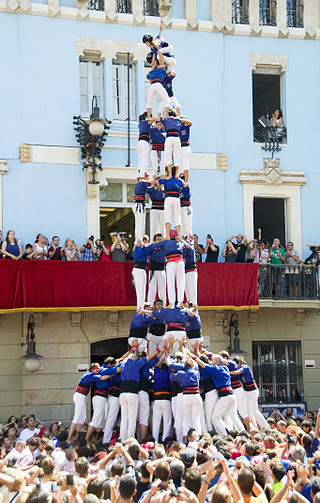
The Castellers de la Vila de Gràcia, created in 1996, are a colla castellera, based in Vila de Gràcia that makes human castles. They made their first public presentation in 1997 supported by the groups Castellers de Terrassa, the Castellers de Sants and the Castellers de Sant Andreu de la Barca. The colour of their shirts is navy blue.
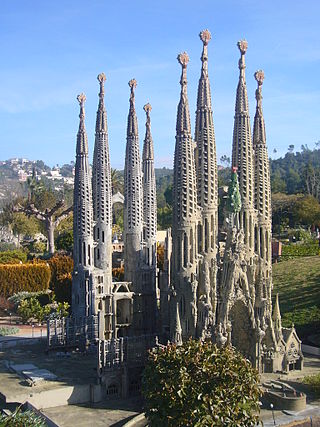
Catalunya en Miniatura is a miniature park inaugurated in 1983 in Torrelles de Llobregat, 17 km (11 mi) from Barcelona. The park is 60,000 m2 (650,000 sq ft), 35,000 m2 (380,000 sq ft) of them devoted to the scale models, it is one of the largest miniature parks in the world, and the largest of the 14 miniature building exhibitions present in Europe. It displays 147 models of palaces, churches, bridges and other buildings from Catalonia and Mallorca and it includes all the major works by the renowned architect Antoni Gaudí.
Marrecs de Salt is a group of castellers from Salt, Girona (Catalonia), founded in 1995. They are also to be considered as the local group in Girona, together with their university counterpart: Xoriguers de la UdG. They are one of the seven active groups in the province of Girona, and since the dissolution of Castellers de l'Albera, also the oldest. Their best human tower is the 5 in 8 and their best performance was on 27 October 2013 for the performance of Sant Narcís in the city of Girona, were they completed the 4 in 8, the 2 in 8 with double base, the 3 in 8 and the pillar of 6. Their shirt is blue standing for the river Ter, which flows through both Salt and Girona, as well as other regions of the province.
The RT2 is a line of Rodalies de Catalunya's Tarragona commuter rail service, operated by Renfe Operadora. It links Port Aventura railway station in the Costa Daurada area with L'Arboç railway station, in Baix Penedès, through the city of Tarragona. The RT2 shares tracks for most of its length with regional rail lines R15, R16 and R17, as well as Barcelona commuter rail service line R4.




















